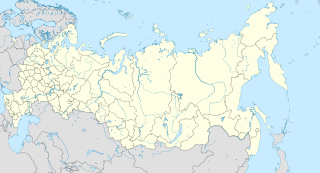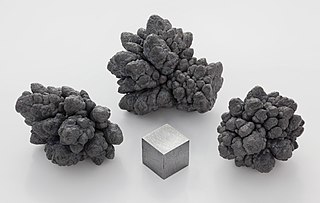
Teck Resources Limited known as Teck Cominco until late 2008, is a Canadian metals and mining company. Canada's largest diversified resources company, it was formed from the amalgamation of Teck and Cominco in 2001.

Mining in Iran is underdeveloped, yet the country is one of the most important mineral producers in the world, ranked among 15 major mineral-rich countries, holding some 68 types of minerals, 37 billion tonnes of proven reserves and more than 57 billion tonnes of potential reserves worth $770 billion in 2014. Mineral production contributes only 0.6 per cent to the country's GDP. Add other mining-related industries and this figure increases to just four per cent (2005). Many factors have contributed to this, namely lack of suitable infrastructure, legal barriers, exploration difficulties, and government control over all resources.

Kipushi is a town in Haut-Katanga District, Democratic Republic of the Congo. It lies 35 km southwest of the city of Lubumbashi, very close to the border with Zambia, at an altitude of 1329 m (4363 ft). The main economic activity of the town is mining. Kipushi is part of the Roman Catholic Diocese of Sakania–Kipushi.
The Cavnic mine is a large mine located in the northwest of Romania in Maramureş County, 26 km southwest of Baia Mare and 576 km north of the capital, Bucharest. Cavnic represents one of the largest polymetallic reserves in Romania having significant reserves of gold, silver, copper, lead and zinc amounting to 20 million tonnes of ore grading 1g/t gold, 30g/t silver, 2% lead, 3% zinc and 1% copper. The resources amount to 640,000 oz of gold, 19.2 million oz of silver, 400,000 tonnes of lead metal, 600,000 tonnes of zinc metal and 200,000 tonnes of copper metal.
The Valea Blaznei mine is a large mine in the north of Romania in Rodna, Bistriţa-Năsăud County, 50 km southwest of Bistriţa and 699 km north-west of the capital, Bucharest. Valea Blaznei represents one of the largest lead and zinc reserve in Romania having estimated reserves of 10.5 million tonnes of ore grading 0.76% lead and 2.48% zinc thus resulting in 0.08 million tonnes of lead and 0.26 million tonnes of zinc.
The Făget mine is a large mine in the northwest of Romania in Rodna, Bistriţa-Năsăud County, 50 km southwest of Bistriţa and 699 km north-west of the capital, Bucharest. Făget represents one of the largest lead and zinc reserve in Romania having estimated reserves of 9.25 million tonnes of ore grading 0.79% lead and 2.48% zinc thus resulting in 0.07 million tonnes of lead and 0.23 million tonnes of zinc.
Mining in North Korea is important to the country's economy. North Korea is naturally abundant in metals such as magnesite, zinc, tungsten, and iron; with magnesite resources of 6 billion tonnes, particularly in the Hamgyeong-do and Jagang-do provinces. However, often these cannot be mined due to the acute shortage of electricity in the country, as well as the lack of proper tools to mine these materials and an antiquated industrial base. Coal, iron ore, limestone, and magnesite deposits are larger than other mineral commodities. Mining joint ventures with other countries include China, Canada, Egypt, and South Korea.
The Ozyorny mine is one of the largest lead and zinc mines in Russia. The mine is located in south-eastern Russia in Buryatia. The mine has reserves amounting to 157 million tonnes of ore grading 1% lead and 5.2% zinc thus resulting 1.57 million tonnes of lead and 8.16 million tonnes of zinc. The mine also has reserves amounting to 800,000 oz of gold and 144 million oz of silver.
The Kišnica mine is one of the largest lead and zinc mines in Kosovo. The mine is located in Novo Brdo in Pristina district. The mine has reserves amounting to 10.3 million tonnes of ore grading 3.77% lead, 1% zinc and 47gr/t silver thus resulting 390,000 tonnes of lead, 103,300 tonnes of zinc and 17 million oz of silver.
The Noyon-Tologoisky mine is one of the largest lead and zinc mines in Russia. The mine is located in southern Russia in Zabaykalsky Krai. The mine has reserves amounting to 14 million tonnes of ore grading 1.79% lead and 1.55% zinc thus resulting 0.25 million tonnes of lead and 0.22 million tonnes of zinc. The mine also has reserves amounting to 30.4 million oz of silver.
The Qingchengzi mine is one of the largest lead and zinc mines in China. The mine is located in Liaoning, northeastern China. The mine has reserves amounting to 29.9 million tonnes of ore grading 2.64% lead and 1.9% zinc thus resulting 0.73 million tonnes of lead and 0.35 million tonnes of zinc.
The Huogeqi mine is one of the largest lead and zinc mines in China. The mine is located in Bayannur, Inner Mongolia. The mine has reserves amounting to 67.6 million tonnes of ore grading 1.44% lead and 1.46% zinc thus resulting 0.97 million tonnes of lead and 1 million tonnes of zinc.
The Salairskoye mine is one of the largest lead mines in Russia. The mine is located in southern Russia in Novosibirsk Oblast. The mine has reserves amounting to 25 million tonnes of ore grading 0.13% lead, 2.42% zinc and 7 million oz of silver.

The Korbalihinskoye mine is one of the largest lead mines in Russia, located in Zmeinogorsky District, Altai Krai. The mine is located in southern Russia in Novosibirsk Oblast. The mine has reserves amounting to 24.5 million tonnes of ore grading 2.01% lead, 9.8% zinc and 43.5 million oz of silver.
The Caijiaying mine is one of the largest lead and zinc mines in China. The mine is located in Zhangjiakou, Hebei province. The mine has reserves amounting to 33.8 million tonnes of ore grading 2.73% lead and 4.26% zinc thus resulting 0.92 million tonnes of lead and 1.44 million tonnes of zinc.
The Blende mine is one of the largest lead and zinc mines in Canada. The mine is located in north-western Canada in Yukon. The mine has reserves amounting to 19.6 million tonnes of ore grading 2.81% lead, 3.04% zinc, 1.72 million oz of gold and 35.1 million oz of silver.
The Kuroko mine is one of the largest lead and zinc mines in United States. The mine is located in Alaska. The mine has reserves amounting to 37 million tonnes of ore grading 0.8% lead, 5.5% zinc, 0.73 million oz of gold and 55.6 million oz of silver.
The Valea Vinului mine is a large mine in the northwest of Romania in Rodna, Bistriţa-Năsăud County. Valea Vinului represents one of the largest lead and zinc reserve in Romania having estimated reserves of 5.25 million tonnes of ore grading 0.79% lead and 2.48% zinc thus resulting in 0.04 million tonnes of lead and 0.13 million tonnes of zinc.
The Tala Hamza mine is one of the largest lead and zinc mines in Algeria. The mine is located in northern Algeria. The mine has reserves amounting to 68.6 million tonnes of ore grading 1.1% lead and 4.6% zinc thus resulting 0.75 million tonnes of lead and 3.15 million tonnes of zinc.
The Duddar mine is one of the largest lead and zinc mines in Pakistan. The mine is located in western Pakistan in Balochistan. The mine has reserves amounting to 50 million tonnes of ore grading 3.2% lead and 7% zinc thus resulting 1.6 million tonnes of lead and 3.5 million tonnes of zinc.






